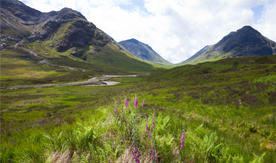
UMaine Researcher: Ocean Stratification Drove Disintegration of Scotland Ice Cap
A University of Maine research team says stratification of the North Atlantic Ocean contributed to summer warming and glacial melting in Scotland during the period recognized for abrupt cooling 12,900 to 11,600 years ago in the Northern Hemisphere.
Prevailing scientific understanding has been that glaciers advanced in the Northern Hemisphere throughout most of the Younger Dryas Stadial (YDS) — a 1,300-year period of dramatic cooling.
But carbon-dated bog sediment indicates the 9,500-square-kilometer ice cap over Rannoch Moor in Scotland retreated at least 500 years before the end of the YDS, says Gordon Bromley, a postdoctoral associate with UMaine’s Climate Change Institute (CCI).
“Our new record, showing warming summers during what traditionally was believed to have been an intensely cold period, adds an exciting new layer of complexity to our understanding of abrupt events and highlights the fact that there is much yet to learn about how our climate can behave,” Bromley says.
“This is an issue that is becoming ever more pressing in the face of global warming, since we really need to know what Earth’s climate system is capable of. But first we have to understand the full nature of abrupt climate events, how they are manifest ‘on the ground.’ And so we were compelled to investigate the terrestrial record of the Younger Dryas, which really is the poster child for abrupt climate change.”
Glaciers, says Bromley, respond to sea surface temperatures and Scotland is immediately downwind of the North Atlantic Ocean.
“Scotland was the natural choice as it lies within the North Atlantic Ocean — widely believed to be a driver of climatic upheaval — and thus would give us a robust idea of what really transpired during that critical period,” he says.
What the team found was that amplified seasonality driven by greatly expanding sea ice resulted in severe winters and warm summers.
While sea ice formation prevented ocean to atmosphere heat transfer during winters, melting of sea ice during summers created a stratified warmer freshwater cap on the ocean surface, he says. The increased summer sea surface temperature and downwind air temperature melted the glaciers.
Bromley says this research highlights the still-incomplete understanding of abrupt climate changes throughout Earth’s history.
“Ever since the existence of abrupt climate change was first recognized in ice-core and marine records, we’ve been wrestling with the problem of why these tumultuous events occur, and how,” he says.
Kurt Rademaker, Brenda Hall, Sean Birkel and Harold W. Borns, all from UMaine’s Climate Change Institute and School of Earth and Climate Sciences, are part of the research team. So too is Aaron Putnam, previously from CCI and now with Lamont-Doherty Earth Observatory at Columbia University/Earth Institute. Joerg Schaefer and Gisela Winckler are also with Lamont-Doherty Earth Observatory and Thomas Lowell is with the University of Cincinnati.
The team’s research paper, Younger Dryas deglaciation of Scotland driven by warming summers, was published April 14 on the “Proceedings of the National Academy of Sciences” website.
Contact: Beth Staples, 207.581.3777
